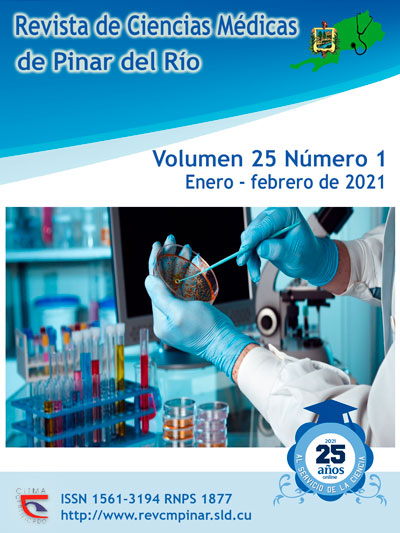Effectiveness of laser therapy and calcium hydroxide on apexogenesis process
Keywords:
TOOTH APEX, LASER THERAPY, ENDODONTICS, CALCIUM HYDROXIDE.Abstract
Introduction: treatment of immature teeth with incomplete apexes is challenging for dentistry professionals.
Case Report: a seven and half-year-old boy who came to the dentist office with antecedents of dental trauma (non-complicated crown fracture), having not treatment in the adequate moment. He was received with a camera abscess for presenting an acute abscess six months after the accident approximately. After the radiological study a necro-pulpectomy was performed with apexogenesis and laser therapy. After a 24-month-treatment and with a very reserved prognosis for having only a third of the root-formation, the treatment was successful, demonstrating the high regenerative power of laser irradiation and calcium hydroxide.
Conclusions: it is an exceptional case that demonstrates the effectiveness of laser therapy and the placing of calcium hydroxide considering the size of the root at initial treatment, the history of an acute abscess, the reinfection during treatment and the periapical bone lysis with radiographic characteristics of a granuloma.
Downloads
References
1. Ayala Pérez Y, Carralero Zaldívar LC, Leyva Ayala BR. La erupción dentaria y sus factores influyentes. CCM [Internet]. 2018 Dic [citado 11/02/2020]; 22(4): 681-694. Disponible en: http://scielo.sld.cu/scielo.php?script=sci_arttext&pid=S1560-43812018000400013&lng=es
2. Mendiburu Zavala CE, Peñaloza Cuevas R, Chuc Baas IR, Medina Peralta S. Enfermedades pulpares y periapicales en estructuras dentales permanentes en pacientes con edades de seis-catorce años. Rev Cubana Estomatol [Internet]. 2017 Jul-Sep [citado 02/07/2018]; 54(3): [aprox. 10 p.]. Disponible en: http://scielo.sld.cu/scielo.php?script=sci_arttext&pid=S0034-75072017000300004
3. Alata Anamaria R. Desarrollo y Erupción Dental. [Tesis]. Perú: Universidad Inca Garcilaso de la Vega. Facultad de Estomatología; © 2019 [citado 11/02/2020]. [Aprox. 54 p.]. Disponible en: http://repositorio.uigv.edu.pe/bitstream/handle/20.500.11818/4729/TRACADEMICO_ALATA%20ANAMARIA%20ROLANDO.pdf?sequence=1&isAllowed=y
4. Moyetones Hernández LE, Zavarce SE. Revascularización en dientes permanentes inmaduros. Estado del Arte. Oral [Internet]. 2018 [citado 02/07/2018]; 19(60): 1615-20. Disponible en: https://www.medigraphic.com/pdfs/oral/ora-2018/ora1860g.pdf
5. Velarde Fernández KM. Diagnóstico y tratamiento pulpar en dentición temprana y permanente joven. [Tesis]. Perú: Universidad Inca Garcilaso de la Vega. Facultad de Estomatología; © 2018 [citado 11/02/2020]. [Aprox. 70 p.]. Disponible en: http://repositorio.uigv.edu.pe/handle/20.500.11818/3927
6. Carrasco Ostos RI. Manejo de terapia pulpar en dientes deciduos y permanentes jóvenes. [Tesis]. Perú: Universidad Inca Garcilaso de la Vega. Facultad de Estomatología; © 2017 [citado 11/02/2020]. [Aprox. 49 p.]. Disponible en: http://repositorio.uigv.edu.pe/bitstream/handle/20.500.11818/1578/TRAB.SUF.PROF.%20ROBER%20IVAN%20CARRASCO%20OSTOS.pdf?sequence=2&isAllowed=y
7. Ramos Núñez PC, Rosales García GJ. Limpieza y obturación del sistema de conductos: biopulpectomía, necropulpectomía y técnica de condensación lateral modificada. Lacandonia [Internet]. 2017 [citado 11/02/2020]; 1(1): 83-96. Disponible en: https://www.academia.edu/15062743/Gilberto_de_Jes%C3%BAs_Rosales_Garc%C3%ADa
8. Peralta Cervantes A, Curiel Torres S. Manejo de la complicación dental postraumática. Un informe del caso. Odontología Vital [Internet]. Junio de 2019 [citado 11/02/2020]; (30): 7-14. Disponible en: http://www.scielo.sa.cr/scielo.php?script=sci_arttext&pid=S1659-07752019000100007&lng=en.
9. Muñoz Cruzatty JP, Arteaga Espinoza SX, Alvarado Solórzano AM. Observaciones acerca del uso del hidróxido de calcio en la endodoncia. Dominio de las Ciencias [Internet]. 2018 [citado 11/02/2020]; 4(1): 352-361. Disponible en: https://dialnet.unirioja.es/servlet/articulo?codigo=6313250
10. Álvarez Rodríguez J, Clavera Vásquez TJ, Chaple Gil AM. Cánula rígida, alternativa en el tratamiento estético-funcional de la apicoformación por fractura complicada de corona. Rev Cubana Estomatol [Internet]. 2016 Mar [citado 12/02/2020]; 53(1): 93-103. Disponible en: http://scielo.sld.cu/scielo.php?script=sci_arttext&pid=S0034-75072016000100010&lng=es
11. Rosales MA, Torre G, Saavedra L, Márquez R, Ruiz MS, Pozos G, et al. Usos del láser terapéutico en Odontopediatría: Revisión de la literatura. Reporte de casos. Odovtos-International Journal of Dental Sciences [Internet]. 2018 [citado 12/02/2020]; 20(3): 51-9. Disponible en: https://www.scielo.sa.cr/pdf/odovtos/v20n3/2215-3411-odovtos-20-03-51.pdf
12. Pérez Morales VS, Fernández González OL, Santana Delgado R, García Martínez Y, Ávila García M, Giance Paz L. Láser de baja potencia en el tratamiento de la estomatitis aftosa recurrente. Mediciego [Internet]. 2017 [citado 12/02/2020]; 22(4): 21-9. Disponible en: https://www.medigraphic.com/pdfs/mediciego/mdc-2016/mdcs161c.pdf
13. Guerra Álvarez PA. Reabsorción Radicular Después del Tratamiento Ortodóncico. [Tesis]. Ecuador: Universidad de San Francisco de Quito USFQ. Facultad de Ciencias de la Salud; © 2017 [citado 11/02/2020]. [Aprox. 52 p.]. Disponible en: http://repositorio.usfq.edu.ec/bitstream/23000/6864/1/134546.pdf
Downloads
Published
How to Cite
Issue
Section
License
Authors who have publications with this journal agree to the following terms: Authors will retain their copyrights and grant the journal the right of first publication of their work, which will be publication of their work, which will be simultaneously subject to the Creative Commons Attribution License (CC-BY-NC 4.0) that allows third parties to share the work as long as its author and first publication in this journal are indicated.
Authors may adopt other non-exclusive license agreements for distribution of the published version of the work (e.g.: deposit it in an institutional telematic archive or publish it in a volume). Likewise, and according to the recommendations of the Medical Sciences Editorial (ECIMED), authors must declare in each article their contribution according to the CRediT taxonomy (contributor roles). This taxonomy includes 14 roles, which can be used to represent the tasks typically performed by contributors in scientific academic production. It should be consulted in monograph) whenever initial publication in this journal is indicated. Authors are allowed and encouraged to disseminate their work through the Internet (e.g., in institutional telematic archives or on their web page) before and during the submission process, which may produce interesting exchanges and increase citations of the published work. (See The effect of open access). https://casrai.org/credit/



